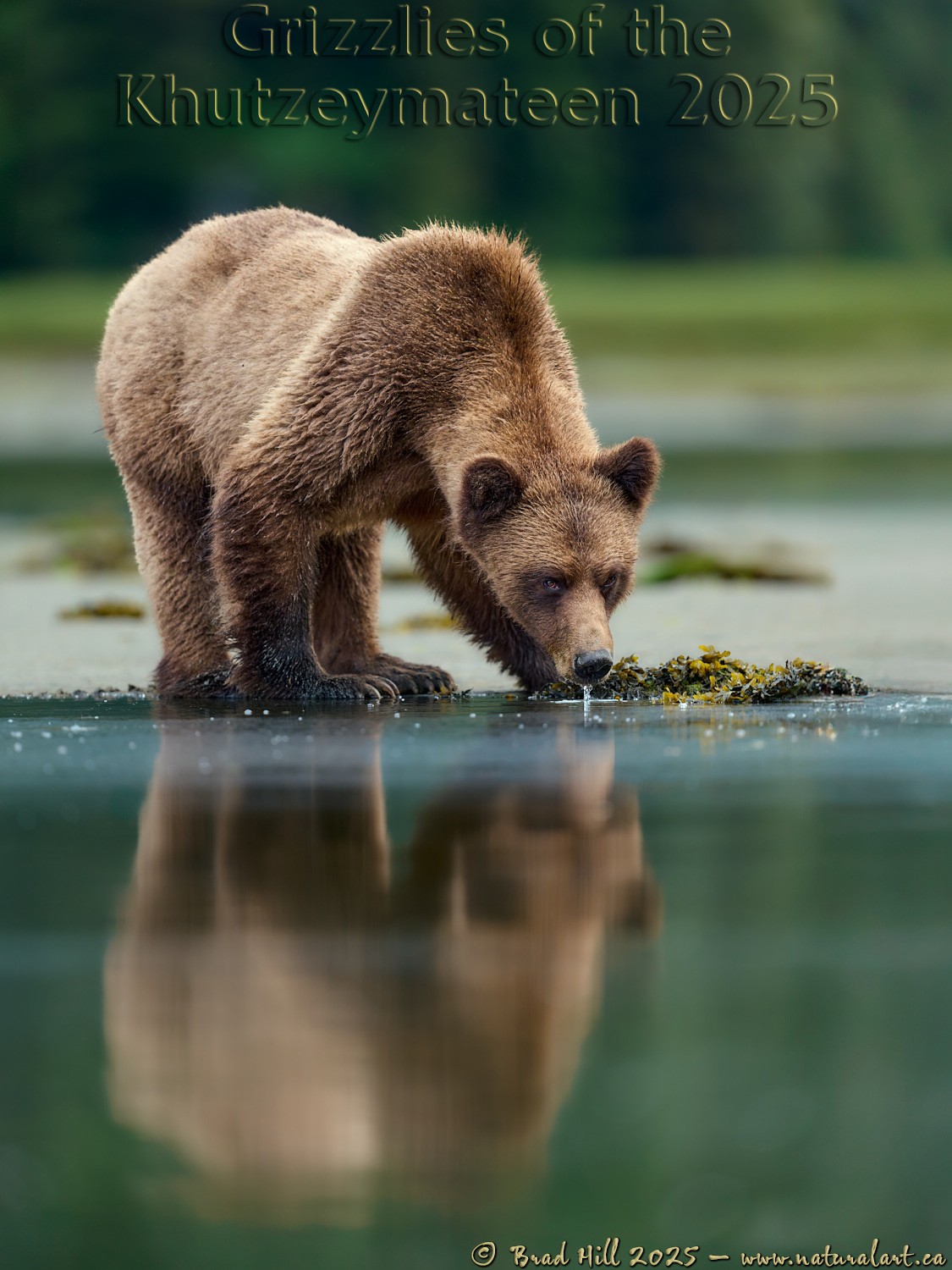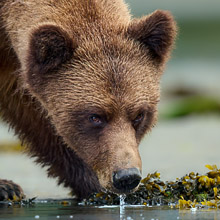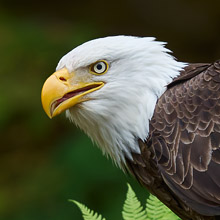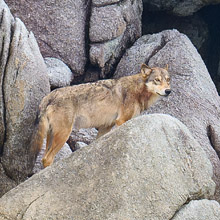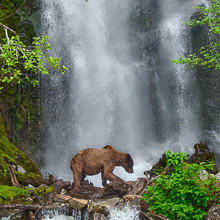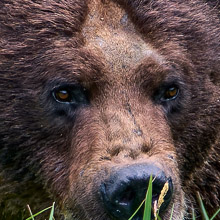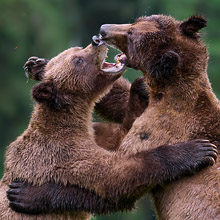Availability: Undetermined - Enquiries?
In the Field
Sharing a Drink. Khutzeymateen Estuary, British Columbia, Canada. May 25, 2025.
What could be better than sharing a cool drink of silty, brackish water on a cool, cloudy day with your on-again, off-again best friend (your reflection)? 😉
I captured this image of a female - and mother - grizzly during my 2025 Grizzlies of the Khutzeymateen Instructional photo tour. Like with almost every approachable grizzly I've worked with over the years this bear keeps close tabs on the strange beings clustered together in their little gray floating home. Here mom is intently watching us as she finishes quenching her thirst (you may have to look at the 4800 pixel image linked below to get a feel for the intensity of her stare).
This image was captured with a Nikon Z 9 paired up with my favourite "expedition" wildlife lens - my Z 400mm f2.8S. As you'd expect when you look at the price tag of this lens it's super sharp (from edge-to-edge) at all apertures. But, equally as important, it renders the out-of-focus (OOF) zones in the image just beautifully, especially if you shoot the lens wide open or very close to it.
But - and this is a very big BUT - if I'm in a situation where I have to hike a significant distance to get to where I want to use the lens - or if I am just out on a "camera walk" looking for wildlife - it's highly unlikely I'll be carrying the Z 400mm f2.8S. Instead it's likely you'd see me with my Z 400mm f4.5S...which is right up there with with the 400mm f2.8 in sharpness AND in the quality of the OOF zones in those apertures that overlap between the two lenses (so at f4.5 and smaller). Of course, some may argue (and I would be among them) that often the most memorable 400mm images ARE captured at f2.8 - or very close to it! So...if you compare the two Z Nikkor 400mm primes you'll find that the 400mm f2.8 CAN produce unique images not possible with the 400mm f4.5 and it adds the benefit of having an integrated 1.4x TC, making it pretty much two lenses in one. But...that 400mm f2.8 is WAY bigger and heavier than the 400mm f4.5 and it will cost you over 4 times as much! Is it worth it? That's up to you to decide. Me? Well...I consider myself very, very lucky to have both.
Here's a larger version (4800 pixel) of this highly reflective grizzly:
• Sharing a Drink: Download 4800 pixel image (JPEG: 3.8 MB)
ADDITIONAL NOTES:
1. These images - in all resolutions - are protected by copyright. I'm fine with personal uses of them (including use as desktop backgrounds or screensavers on your own computer), but unauthorized commercial use of the image is prohibited by law. Thanks in advance for respecting my copyright!
2. Like all photographs on this website, these images were captured following the strict ethical guidelines described in The Wildlife FIRST! Principles of Photographer Conduct. As such, no baiting or any form of attractant was used and, as always, we attempted to minimize our impact on the ongoing behaviour of the subjects. I strongly encourage all wildlife photographers to always put the welfare of their subjects above the value of their photographs.
3. This image was captured during my Grizzlies of the Khutzeymateen instructional photo tour in late spring of 2025. Each year I offer trips into the Great Bear Rainforest as well as tours into the Khutzeymateen Grizzly Sanctuary (to photograph grizzlies, of course!). Details about these trips can be found on the Photo Tours page of this website.
Behind the Camera
Sharing a Drink. Khutzeymateen Estuary, British Columbia, Canada. May 25, 2025.
High Efficiency* Compressed RAW (NEF) format; ISO 1100.
Nikon Z 9 paired with Nikkor Z 400mm f2.8S. Hand-held from a floating Zodiac inflatable boat. VR on in Sport mode. 3D-tracking AF area mode with subject detection on "Animal" mode.
1/400s @ f3.2; -0.7 stop compensation from matrix-metered exposure setting.
At the Computer
Sharing a Drink. Khutzeymateen Estuary, British Columbia, Canada. May 25, 2025.
Initial noise reduction and capture sharpening on the .nef (raw) file using the DeepPRIME XD2S algorithm of DXO PhotoLab 8.7 Elite (using the appropriate lens/camera optical module).
Subsequent adjustments to the adjusted linear DNG file (exported from PhotoLab) and conversion to 16-bit TIFF file (and JPEG files for web use) - including all global and selective adjustments - made using Capture One Pro (build 16.6.3). In the case of this image the only global adjustment was a minor tweak to contrast (a Levels adjustment). Selective local adjustments performed using Capture One Pro's layers and masking tools. In this case numerous small adjustments and minor tweaks were made on 5 separate layers, with the tweaks being associated with "exposure balancing" and contrast adjustments (such as adjustments to brightness, clarity, highlights, shadows, etc.).
Photoshop modifications included insertion of the watermark and/or text.
Conservation
Sharing a Drink. Khutzeymateen Estuary, British Columbia, Canada. May 25, 2025.
Species Status in Canada*: Special Concern (May 2002).
While Grizzly Bears (Ursus arctos) are not technically listed as "Endangered" in Canada, they have been extirpated from most of their historical range. Grizzly Bears are far more sensitive to intrusion/disturbance in their habitat than are Black Bears and are being increasingly forced into marginal habitat by human encroachment. The Great Bear Rainforest along the central and northern coast of British Columbia is one of the last strongholds of the Grizzly Bear in Canada, and even this population is coming under increasing pressure.
On December 18, 2017 the government of British Columbia banned grizzly hunting across the entire province. This major conservation victory came after decades of tireless work by many dedicated conservationists and ecologists and, most importantly, it reflects the opinion of the vast majority of British Columbians. And, it means that AT LEAST while the current government remains in power grizzlies are finally "safe" in British Columbia.
Now that we've at least temporarily won the battle to save grizzlies in BC, it's time to re-focus our efforts toward protecting ALL of BC's carnivores, including Gray Wolves, Black Bears, Cougars, Wolverines, and more! Simply put, there are no ecological, economic, or ethical arguments supporting the trophy hunting of carnivores.
*as determined by COSEWIC: The Committee on the Status of Endangered Wildlife in Canada













